“Science through Minecraft.” It was Sammi Y’s idea.
Hi Mr. Kahn, I am a parent of an avid 9 year old Minecraft fan in Los Angeles. I have been reading your blog about your middle school students with great interest….Since my son has become a MC fan (and has pulled his friends into it as well), I have gradually become a fan, too. I even some how managed with my son to set up a multiplayer server via Hamachi by viewing youtube videos….Anyway, my son and his friends are quite proficient in all things MC. I am very pleased with all the creativity, math, engineering, computer skills (typing, commands, understanding of internet/servers), designing, architecture, and surprisingly, social skills and friend-building that MC has to offer…The reason why I’m emailing you today is because I have been looking for someone who could teach my son more about MC from an educational point of view…. [maybe] a class called “Science through Minecraft”–like that cool way in which the kids on your blog used MC to design their interpretations of a cell. If you could create a simple lesson about a topic in science and then let the kids do something with that theme in MC, that would be a show-stopper. We are willing to be guinea pigs! BTY- MC user names have been modified.
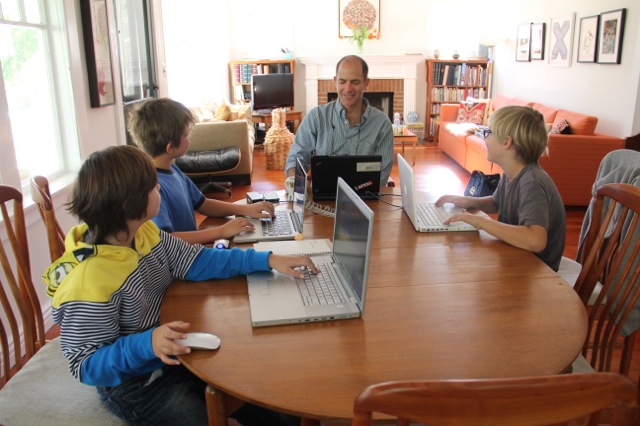
The guinea pigs, myself included.
Today was our first meeting of “Science through Minecraft.” I spent some time thinking about a good topic to start with. I came up with a question that I actually did not really know the answer to. I think Papert would approve of this as authentic learning. I drew inspiration for my question from a video called Gravity Lab produced by MinecraftEduElfie. My goal however was not for the kids to investigate gravity, but to investigate if a feather falls faster than sand or gravel. My intention was for the kids to find out whether or not there is an atmosphere in Minecraft.
I met Sammi Y, Zoynga, Yoyo and Rudy at one of their homes. Yoyo expertly set up a LAN server for our session: flat grassland, creative mode. I presented my question to the kids. What would fall faster in Minecraft, a feather or sand? I asked one of the kids if he had a feather. He quickly produced one and a super ball. I asked him to hold them high and drop them. Which would hit the ground first? They all agreed that the ball would. Why? Various excited responses were shouted out, and eventually they arrived at the fact that the air slows down the feather because “it is spread out more and lighter.”
Their task- Design (actually build) an experiment to test whether a feather falls slower than sand in Minecraft. Ultimately, this would inform us on whether there is air or an atmosphere in Minecraft. The three kids set out to design their experiments.
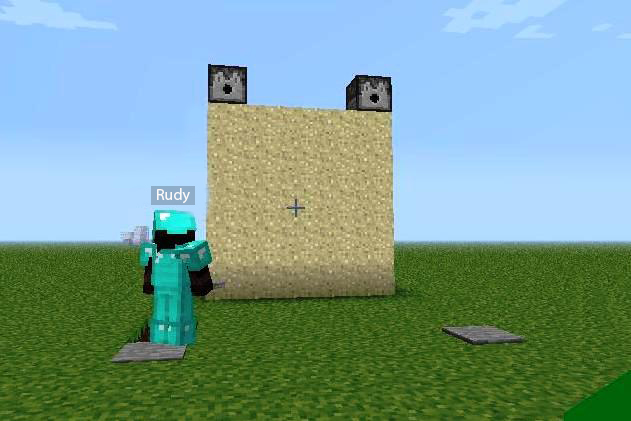
To the left is Rudy’s first attempt. The dispensers “chuck” a feather and a sand block at the same time and pressure plates act as sensors. While testing, he realized that the dispensers did not always chuck the items to exactly the same place. Rudy created walls to guide the feather and sand block onto the pressure plates. He used redstone to connect the pressure plates to lit torches that would turn off when the objects landed on the plates. To chuck the feather and sand block at the same time Rudy installed a pressure 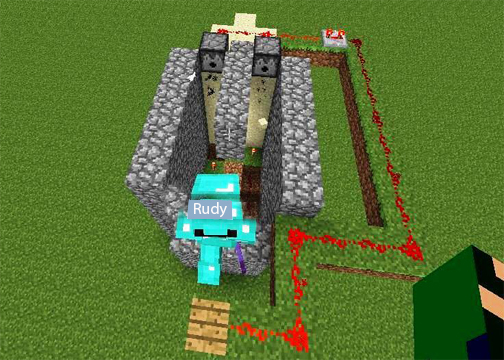 plate to stand on and trigger the dispensers. After several tests Rudy excitedly claimed “the sand block falls faster.” Then he noticed “the feathers and rocks were hitting the walls and that’s affecting how they fell. It’s chucking it against the wall and its moving backwards.” Look carefully in the screen shot; you can see the feather and the sand block.
plate to stand on and trigger the dispensers. After several tests Rudy excitedly claimed “the sand block falls faster.” Then he noticed “the feathers and rocks were hitting the walls and that’s affecting how they fell. It’s chucking it against the wall and its moving backwards.” Look carefully in the screen shot; you can see the feather and the sand block.
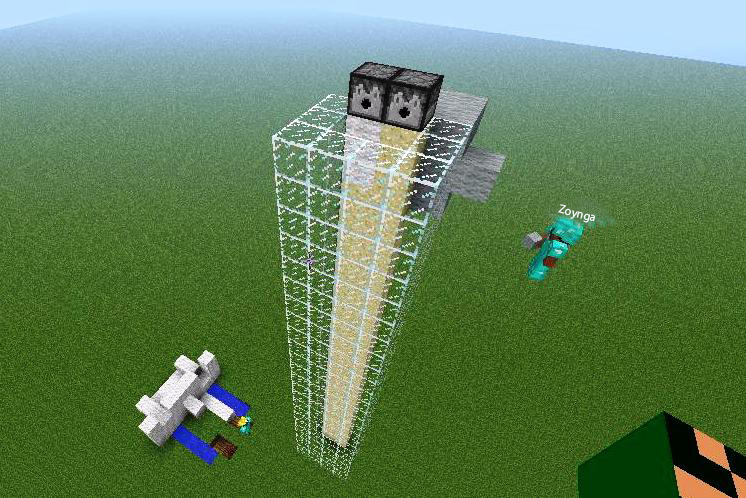 Zoynga, a boy 2 years older than Rudy and Yoyo, produced a different apparatus. His apparatus included dispensers and glass containment walls for the falling objects. In addition, he included more height, which in my opinion would magnify any difference in the falling rates of the feather and sand block and provide more accurate results. Zoynga abandoned this idea when he discovered that the redstone required to power the dispensers would be too much to deal with (in background); he moved on to a new design, as shown below.
Zoynga, a boy 2 years older than Rudy and Yoyo, produced a different apparatus. His apparatus included dispensers and glass containment walls for the falling objects. In addition, he included more height, which in my opinion would magnify any difference in the falling rates of the feather and sand block and provide more accurate results. Zoynga abandoned this idea when he discovered that the redstone required to power the dispensers would be too much to deal with (in background); he moved on to a new design, as shown below.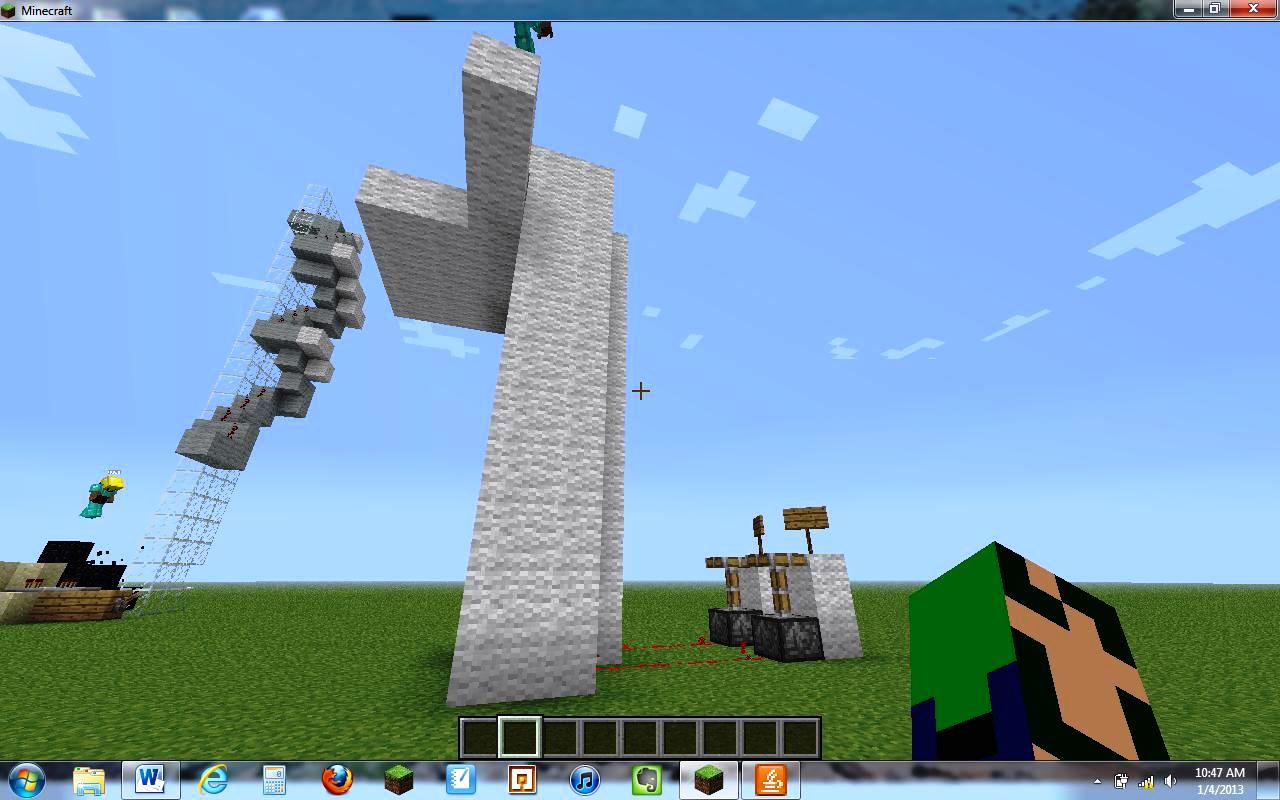 Also powered by redstone, Zoynga employed pistons as his output instead of torches. As Zoynga continued working on his new design, he noticed “there is a mistake in my work.” In addition he noticed “the dispensers aren’t throwing the things with the same force.” Good observations.
Also powered by redstone, Zoynga employed pistons as his output instead of torches. As Zoynga continued working on his new design, he noticed “there is a mistake in my work.” In addition he noticed “the dispensers aren’t throwing the things with the same force.” Good observations.
At this point, the kids became distracted and began playing outside the context of the experiment by shooting flaming arrows at each other. I thought to myself “that wasn’t bad; 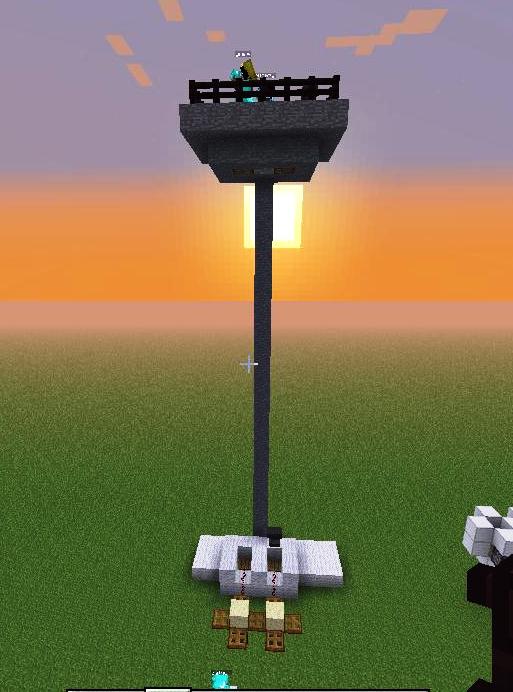 I had them for about an hour.” Instead of corralling them back to the assignment, I simply began building my own design. I got about as far as the main platform at the top when Zoynga noticed what I was doing and joined in. It wasn’t long before both Yoyo and Rudy were there too. Instead of dispensers this time, they used trap doors to release the objects.
I had them for about an hour.” Instead of corralling them back to the assignment, I simply began building my own design. I got about as far as the main platform at the top when Zoynga noticed what I was doing and joined in. It wasn’t long before both Yoyo and Rudy were there too. Instead of dispensers this time, they used trap doors to release the objects. 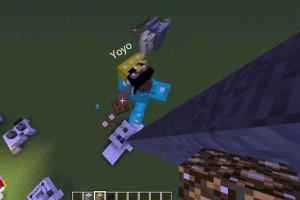 Below, they used pressure plates as the sensors and pistons as the output. Symbolically, the sun is setting in the background.
Below, they used pressure plates as the sensors and pistons as the output. Symbolically, the sun is setting in the background.
Experimental conclusion: After several tests, we concluded that the feather and the block of sand fell at the same rate and thus there is no air or atmosphere in Minecraft. I then posed the the question to the kids about the clouds in Minecraft. I asked them what makes clouds move in the real world- air, moving air. So they realized the results of our experiment and the moving clouds in Minecraft are contradictory to each other.
Guinea pig conclusion: Overall I think the the meeting was a great success and I 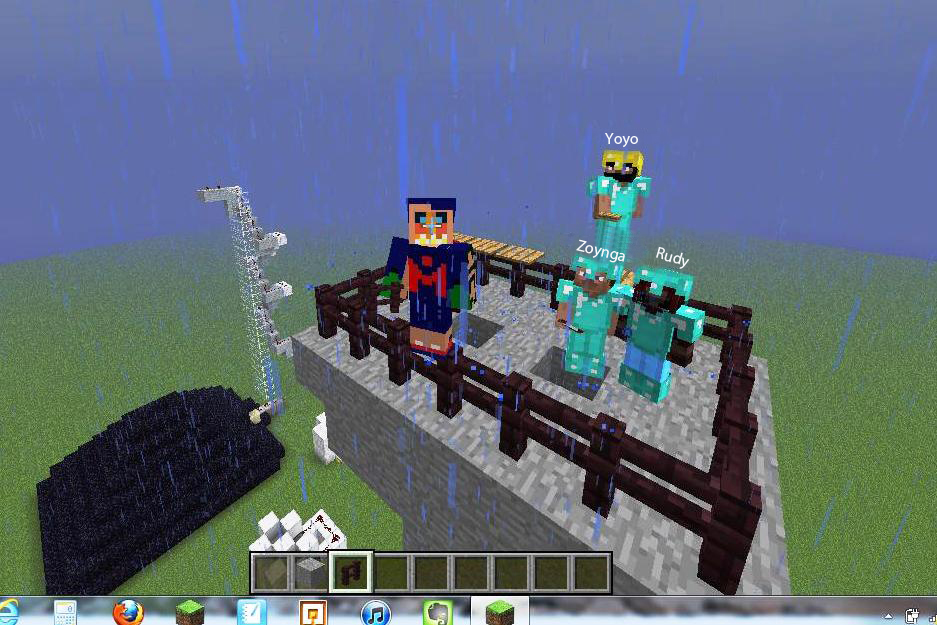 commend Sammi Y for reaching out to me. The small tutorial setting outside of school was very enjoyable for all of us. Moreover, using Minecraft to inform kids about science and how the world works was totally effective. The kids engaged in authentic scientific problem solving as they designed their experiments. Sammi Y felt similarly. Her son said he had the chance “to think about new things in science.” Zoynga said that he “wished
commend Sammi Y for reaching out to me. The small tutorial setting outside of school was very enjoyable for all of us. Moreover, using Minecraft to inform kids about science and how the world works was totally effective. The kids engaged in authentic scientific problem solving as they designed their experiments. Sammi Y felt similarly. Her son said he had the chance “to think about new things in science.” Zoynga said that he “wished 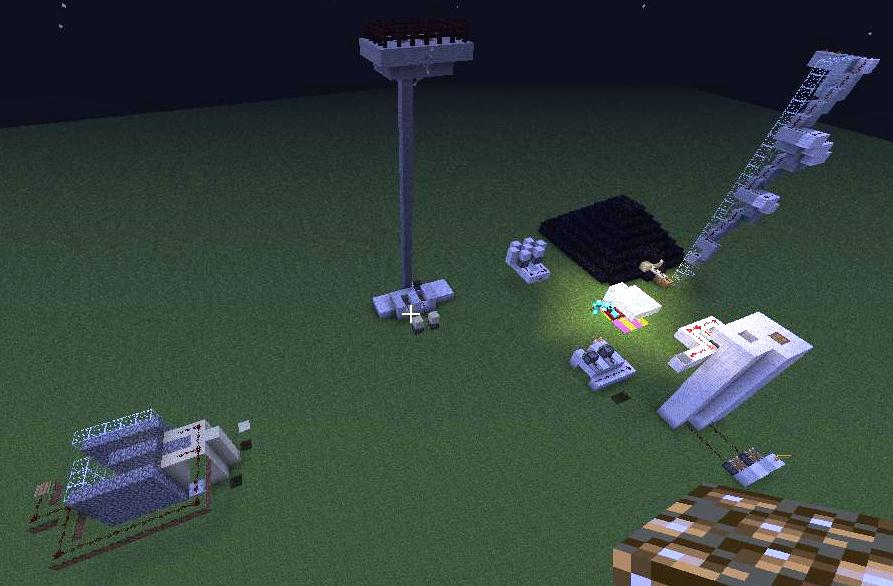 they could have done more experiments.” I agree with Zoynga; I think Minecraft is a great platform in which to conduct experiments.
they could have done more experiments.” I agree with Zoynga; I think Minecraft is a great platform in which to conduct experiments.
In a follow up email, Sammi Y wrote: ” I loved how you had the kids think about science concepts in the “real world” and then related it to their MC worlds and vice versa. One of the things that I really wish the kids could do more of is this–connecting the dots between their discoveries in the two worlds which should then, enrich both! Comparing of gravity/air in our world vs MC was great! The only worry I had is that they seemed to get a bit distracted in their own little MC world during class so unless the lesson is quite focused and deliberate, good learning moments might be lost.”
My response to her ‘worry’ was the following:
“I think the openendedness (if that is a word) is valuable for kids. I like the idea of giving them a task and letting them go for it and put their own spin on it. Kids go in different directions as you saw with this experiment. I’ve read some incredible books lately that have been informing my technological epiphany, One of which is called The Children’s Machine, by Seymour Papert. He describes authentic learning being real and not a “treatment” with steps and procedures provided by a teacher that already knows the outcome. Indeed, one of the boys asked if I knew what was going to happen. I was happy to be able to say that I honestly did not.”
I am happy with the science outcome of this activity; I like to think that Papert would be happy with the way I conducted it.
This was a long post and I thank you for reading.


Pingback: The school where everyone must play Minecraft | Thames Valley Berkshire Climate Challenge
If you ever need another guinea pig I know exactly where you can find one…
Maybe we can set something up with your guinea pig and some of his friends.
This was fascinating! And we are also on the lookout for MC learning opportunities like this ;).
Thanks so much for your comment. I am happy that you found it interesting. Good luck with your Minecraft endeavors.
Pingback: The school where everyone is encouraged to play Minecraft | blog.multimedialab.org.uk
While doing my homework for Earth Science, I found myself thinking that Minecraft could be a great way to reach other kids and teach them things. After all, I’ve gained by history skills from the game series, “Assassins Creed.” Although Minecraft has it’s flaws, I believe that it’d be a fun and mind-reaching way to teach kids and teenagers alike.
Great work you’re doing.
Thanks so much for you comment. I obviously agree with. Stay tuned as I am preparing another blog post about working with the same kids and teaching them another topic in science using Minecraft.
Pingback: Genetics in Minecraft: Wool, Mendel and Brownies: | Middle School Minecraft
I teach Middle School Minecraft as a stand alone 12 week class that meets daily. My next unit with the 6th grade class, is a science unit focused on conducting experiments! I built a large “Science lab” complete with “offices” for each set of students, and they are going to design and conduct experiments and then post info blocks, signs, and write book detailing their findings! I stumbled across your blog as I was looking for ideas to present to them. I am putting your feather , sand, atmosphere experiment on my list! I love running across other like minded educators!
Sarai,
Thank you for your comment. I think Minecraft is a great sandbox for students.
I looked at your blog and already came with a great math algebra problem. They do perimeter problems.
How much more engaging it would it be for kids to do this calculation in an environment they can manipulate. Thanks for getting in contact.
Cheers,
Bob
Curso será ministrado pela mestra Regina Moura, que vai ensinar receitas a sustento a mel original e com recheio
de nozes, além a trufas nos sabores tradicional, framboesa
com cream cheese, menta e ‘sensação’ com abacaxi.
Great post. I used to be checking constantly this blog and I am inspired!
Extremely useful information specifically the remaining section 🙂 I
maintain such information a lot. I was looking for this particular info for
a long time. Thanks and best of luck.
Admiring the hard work you put into your site and in depth information you provide.
It’s great to come across a blog every once in a while that isn’t the same outdated rehashed information. Fantastic
read! I’ve bookmarked your site and I’m including your RSS feeds to my Google account.